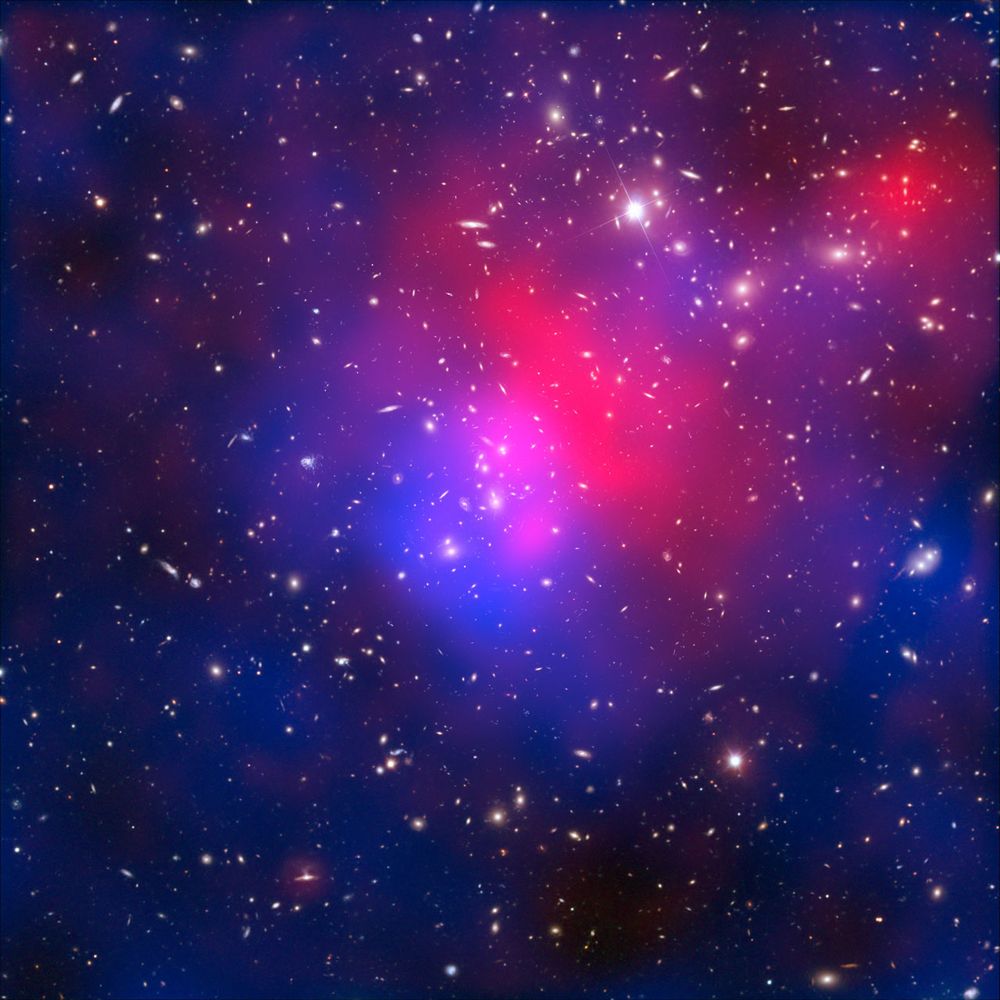Strange Galaxy Cluster Born From Huge Cosmic Crash

A distant galaxy cluster was spawned by a huge cosmic smash-up of four different clusters, which lasted hundreds of millions of years, a new study suggests.
A team of scientists pieced together the violent history of the galaxy cluster Abell 2744, also known as Pandora's Cluster, using several different telescopes in space and on the ground. Abell 2744 seems to be the result of a merger of four separate clusters that took place over a period of 350 million years, researchers said.
"We nicknamed it Pandora’s Cluster because so many different and strange phenomena were unleashed by the collision," said study author Renato Dupke, of the University of Michigan, in a statement. "Some of these phenomena had never been seen before." [See new photo of the galaxy cluster]
A huge, distant cluster
Galaxy clusters — groupings of hundreds of individual galaxies — are the largest structures in the universe bound together by gravity. Abell 2744 is located a little more than 3 billion light-years away from our own Milky Way.
To try to figure out what happened in Abell 2744, researchers studied the cluster using several different instruments: NASA's Hubble and Chandra space telescopes, the European Southern Observatory's Very Large Telescope (VLT) in Chile and Japan's Subaru telescope in Hawaii.
Specifically, the team mapped out where Abell 2744's various types of mass and matter are found.
Sign up for the Live Science daily newsletter now
Get the world’s most fascinating discoveries delivered straight to your inbox.
The researchers found that galaxies in the huge cluster, which are clearly visible in the Hubble and VLT images, make up less than 5 percent of Abell 2744's mass. Another 20 percent is gas, which is so hot that it shines only in X-rays; Chandra detected and mapped out this material.
The rest of the cluster's mass is dark matter — mysterious stuff that scientists can't directly detect because it doesn't interact with "normal" matter.
Dark matter only betrays its presence through its gravitational effects. To pinpoint the location of Abell 2744's dark matter, the researchers exploited a phenomenon known as "gravitational lensing." This term describes the way light rays from even more distant galaxies are bent as they pass through the cluster's gravitational field on their way to Earth.
This warping of light causes a series of telltale distortions in the galaxies' images, which can be seen in the Hubble and VLT observations. By carefully plotting the way that these images are distorted, it is possible to map accurately where the mass, and thus the dark matter, actually lies. [Stunning Photos From Paranal Observatory]
Mapping out Abell 2744's matter
All in all, the various telescopes' observations showed ample evidence of a complex and violent collision, which produced some surprising results.
"Abell 2744 seems to have formed from four different clusters involved in a series of collisions over a period of some 350 million years," said Dan Coe of the Space Telescope Science Institute in Baltimore, one of the study's two lead authors. "The complicated and uneven distribution of the different types of matter is extremely unusual and fascinating."
It seems that the complex collision separated out some of the hot gas and dark matter so that they now lie apart from each other, and apart from the visible galaxies, researchers said. Pandora’s Cluster combines several phenomena that have only ever been seen singly in other systems.
Near the core of the cluster is a "bullet," where the gas of one cluster collided with that of another to create a shock wave. The dark matter apparently passed through the collision unaffected.
In another part of the cluster, there seem to be galaxies and dark matter, but no hot gas. The gas may have been stripped away during the collision, leaving behind no more than a faint trail, researchers said.
Even odder features lie in the outer parts of the cluster. One region contains lots of dark matter, but no luminous galaxies or hot gas. A separate ghostly clump of gas has been ejected, which precedes rather than follows the associated dark matter.
This puzzling arrangement may be telling astronomers something about how dark matter behaves and how the various ingredients of the universe interact with each other, researchers said. They hope to find out more, and are undertaking further study of Abell 2744.
This story was provided by SPACE.com, a sister site to LiveScience. Follow SPACE.com for the latest in space science and exploration news on Twitter @Spacedotcom and on Facebook.













